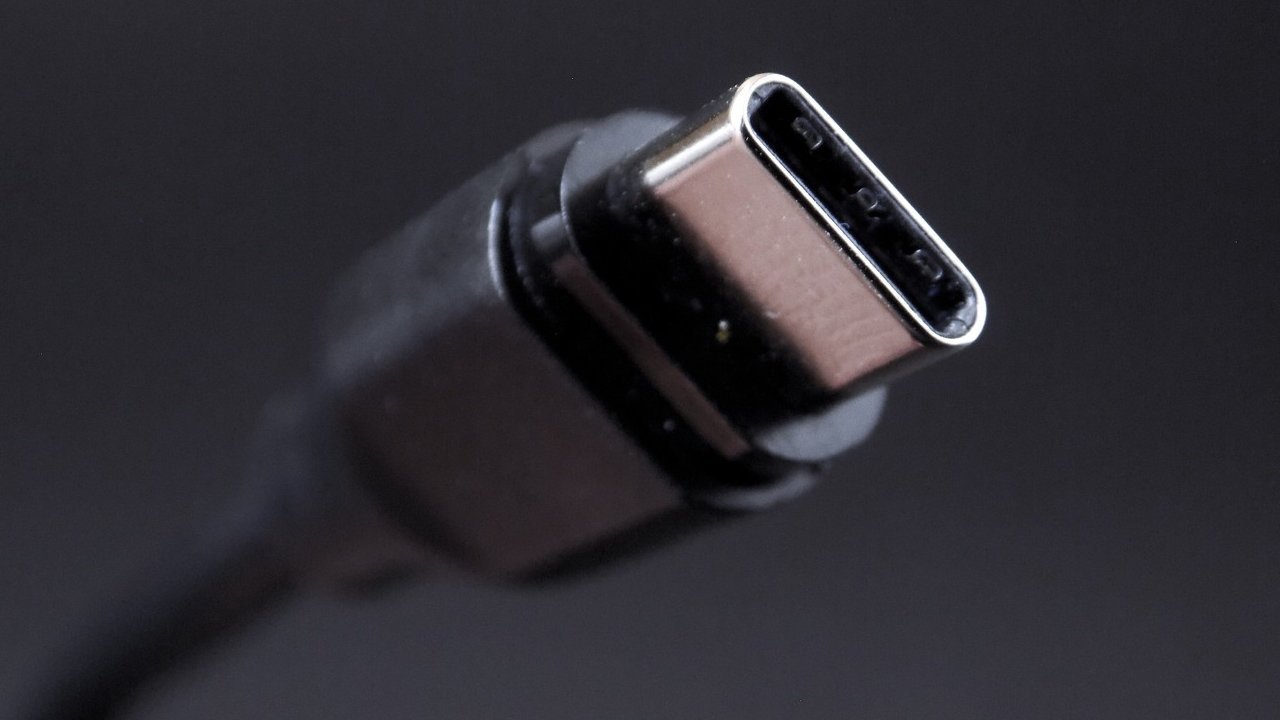Tenth-gen iPad's USB-C limited to Lightning speeds
Apple's addition of USB-C to the iPad doesn't offer all of the benefits of the port, with it limited to transfer speeds equal to the Lightning connector it replaces.

A USB-C cable.
The migration to USB-C from Lightning offers many advantages, such as being able to connect the iPad to many USB-C accessories. However, it seems that while the physical connector is in place, it's not working at the high speed expected of USB-C.
Initially reported by The Verge, the tenth-generation iPad's USB-C works as expected for charging, but for data, it connects only at "USB 2.0 data speeds." At 480Mbps, this is the same speed offered by Lightning, as used on the ninth-gen iPad.
The connection can still handle external monitors, though up to 30fps for a 4K resolution and up to 60fps for 1080p.
The 480Mbps speed is a far cry from what USB-C is capable of. For example, the iPad Pro uses Thunderbolt USB-C connections that can transfer at up to 40Gbps, meanwhile the USB-C in the iPad Air and iPad mini manages 10Gbps and 5Gbps respectively.
Apple does not mention the limited speed of the iPad's USB-C port, but it is unlikely to be a factor for most end users, except in cases where they must perform large file transfers to a computer, or need to restore a backup.
Read on AppleInsider

A USB-C cable.
The migration to USB-C from Lightning offers many advantages, such as being able to connect the iPad to many USB-C accessories. However, it seems that while the physical connector is in place, it's not working at the high speed expected of USB-C.
Initially reported by The Verge, the tenth-generation iPad's USB-C works as expected for charging, but for data, it connects only at "USB 2.0 data speeds." At 480Mbps, this is the same speed offered by Lightning, as used on the ninth-gen iPad.
The connection can still handle external monitors, though up to 30fps for a 4K resolution and up to 60fps for 1080p.
The 480Mbps speed is a far cry from what USB-C is capable of. For example, the iPad Pro uses Thunderbolt USB-C connections that can transfer at up to 40Gbps, meanwhile the USB-C in the iPad Air and iPad mini manages 10Gbps and 5Gbps respectively.
Apple does not mention the limited speed of the iPad's USB-C port, but it is unlikely to be a factor for most end users, except in cases where they must perform large file transfers to a computer, or need to restore a backup.
Read on AppleInsider

Comments
The goal of USB4 being the requirement is to stop cable waste. The law doesn't require that devices have to meet the full speed specs. Higher speed often means more power. With USB-C cables, you are guaranteed that you'll have the minimum specs met for the cable, not for the device. It does state that it must be labeled for its capacities.
I very much welcome the mandate. I am tired of dealing with different cables. Also, it should mandate that for many appliances, not just computers like beard trimmers, electric brushes, et al. I am sick of losing cables for them. With the USB4, I'd never have to deal with that.
If you encounter a device equipped with a USB-C port/connector you have no idea about what protocols are supported through that connector until you dig into the product specifications. You don't know if the USB-C connector supports USB2, USB3, USB-3.1, USB-3.2, USB3.1 Gen 1, USB3.2 Gen 2, USB-4, Thunderbolt 3, Thunderbolt 4, power charging, power delivery, DisplayPort, etc.
Same deal with the cables that you purchase to plug into those USB-C ports. Some cables only support a subset of the protocols that can exist behind the USB-C port. A USB-C cable that's designed for USB-3.1 will very likely not support a high-resolution monitor that requires USB 3.1 Gen 2 or USB 3.2 Gen 2 with DisplayPort support. There's a very good reason why some 1m USB-C cables cost $15.00 USD and some 1m USB-C cables cost $129.00 USD (like Apple's TB3 USB-C cables do).
Until buyers of products with USB-C connectors dig into what protocols and capabilities are supported by those connectors it is a mystery. Fortunately, once you unravel the mystery and understand what your USB-C connectors can do you can buy the right cable for the functionality you need. No big deal. By the way, devices equipped with multiple USB-C ports, e.g., the Mac Studio, do not always support the same protocols on every USB-C port. The rear ports USB-C ports on Mac Studio computers support Thunderbolt 4 and the front USB-C ports can support either USB-3.1 Gen 2 or Thunderbolt 4, depending on the Mac Studio model you purchase.
Time will tell whether the mandate for USB-C connectors on consumer products will result in a reduction in electronic waste. I'd hate to see someone purchase a $129.00 USD cable that has the mandated USB-C connectors on both ends just to charge their beard trimmer. Ouch! Likewise, I'd hate to see someone attempt to use the USB-C cable that came with their beard trimmer to connect their computer to a high speed backup drive or to a monitor.
This really is about the upsell by creating a bullet point difference, although I am at a loss to see where it could be. it isn’t as though the intersection of 10th gen ipad owners and owners of thunderbolt peripherals on any venn diagram would have a large enough area to be observable.
Apple doesn't provide on iPad Pro M1 with its Thunderbolt only about 500 MB/s instead something closer to Thunderbolt Speeds 40 Gb/s.
The port/connector (USB Type C) and the protocols (TB3, TB4, USB 3.1, etc.) are separate. The EU does not specify the protocols, only the port/connector. Nobody is "limiting" anything.